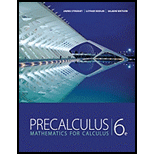
(a)
To find: The function that has a horizontal asymptote out of the given functions.
(a)
Answer to Problem 12T
The function that has a horizontal asymptote are
Explanation of Solution
Given information:
The given functions are
Calculation:
Check the functions that has a finite limit as
Check the limit.
So, the horizontal asymptote of the function
Check the limit.
So, there is no horizontal asymptote of the function
Check the limit.
So, there is no horizontal asymptote of the function
Check the limit.
So, the horizontal asymptote of the function
Therefore, the function that has a horizontal asymptote are
(b)
To find: The function that has a slant asymptote.
(b)
Answer to Problem 12T
The function that has a slant asymptote is
Explanation of Solution
Given information:
The given functions are
Calculation:
For the function to have a slant asymptote the degree of the numerator must one greater than the degree of the denominator.
Out of the given functions only
Therefore, the function that has a slant asymptote is
(c)
To find: The function that has no vertical asymptote.
(c)
Answer to Problem 12T
The function that has no vertical asymptote is
Explanation of Solution
Given information:
The given functions are
Calculation:
For the function to have a vertical asymptote the denominator of the function must not be equal to
Out of the given functions only
Therefore, the function that has no vertical asymptote is
(d)
To graph: The function
(d)
Explanation of Solution
Given information:
The given functions are
Graph:
As the function
Sketch the graph of the function with horizontal and vertical asymptotes.

Figure(1)
(e)
To find: The polynomial
(e)
Answer to Problem 12T
The polynomial
Explanation of Solution
Given information:
The given functions are
Calculation:
Simplify the function with division algorithm.
So, by the division the function
Therefore, the polynomial
Sketch the graph of the function

Figure(2)
Chapter 3 Solutions
Precalculus: Mathematics for Calculus - 6th Edition
 Calculus: Early TranscendentalsCalculusISBN:9781285741550Author:James StewartPublisher:Cengage Learning
Calculus: Early TranscendentalsCalculusISBN:9781285741550Author:James StewartPublisher:Cengage Learning Thomas' Calculus (14th Edition)CalculusISBN:9780134438986Author:Joel R. Hass, Christopher E. Heil, Maurice D. WeirPublisher:PEARSON
Thomas' Calculus (14th Edition)CalculusISBN:9780134438986Author:Joel R. Hass, Christopher E. Heil, Maurice D. WeirPublisher:PEARSON Calculus: Early Transcendentals (3rd Edition)CalculusISBN:9780134763644Author:William L. Briggs, Lyle Cochran, Bernard Gillett, Eric SchulzPublisher:PEARSON
Calculus: Early Transcendentals (3rd Edition)CalculusISBN:9780134763644Author:William L. Briggs, Lyle Cochran, Bernard Gillett, Eric SchulzPublisher:PEARSON Calculus: Early TranscendentalsCalculusISBN:9781319050740Author:Jon Rogawski, Colin Adams, Robert FranzosaPublisher:W. H. Freeman
Calculus: Early TranscendentalsCalculusISBN:9781319050740Author:Jon Rogawski, Colin Adams, Robert FranzosaPublisher:W. H. Freeman
 Calculus: Early Transcendental FunctionsCalculusISBN:9781337552516Author:Ron Larson, Bruce H. EdwardsPublisher:Cengage Learning
Calculus: Early Transcendental FunctionsCalculusISBN:9781337552516Author:Ron Larson, Bruce H. EdwardsPublisher:Cengage Learning





